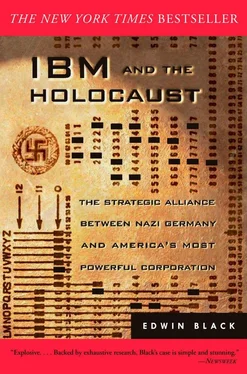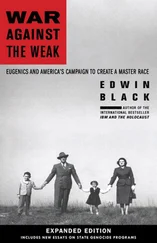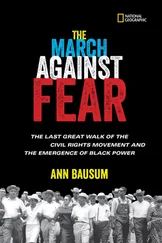Anti-Semitic violence and general repression in Germany was an undeniable fact for all in America, but especially for anyone who could read the front page or the first few pages of the New York Times, listen to a radio broadcast, or watch a newsreel. In the formative months of February, March, and April 1933, Watson and his colleagues at IBM were exposed to not just several articles in the New York Times, but scores of them each week detailing ghastly anti-Semitic brutality. On many days, the New York papers were filled with literally dozens of repression and atrocity reports.
March 18, New York Times : In an article detailing Nazi plans to destroy Jewish professional life, the paper reported that a quarter of all Jewish attorneys would be forced to retire each year until they were all gone. It wasn’t just the legal profession. Within weeks all German Jews expected to be ousted from their professional positions and occupations, the paper wrote. 46
March 20, New York Times : The page one center headline decried, “German Fugitives Tell of Atrocities at Hands of Nazis.” Making clear that “iron-clad censorship” in Germany was preventing most of the truth from emerging, the paper nonetheless enumerated a series of heinous acts. For example, at Alexanderplatz in Berlin, just down the street from the Prussian Statistical Office complex, Brown Shirts invaded a restaurant popular with Jewish businessmen. Waving a list of names of the restaurant’s Jewish customers, the Brown Shirts “formed a double line to the restaurant door.” They called each Jew out by name and made him run a gauntlet. As a Jew passed, each Storm Trooper “smashed him in the face and kicked him with heavy boots, until finally the last in the line, knocked him into the street.” The last Jew to run the gauntlet was beaten so severely, “his face resembled a beefsteak,” the newspaper reported. 47
March 21, New York Times : Under a page one banner headline declaring, “Reichstag Meeting Today is Prepared to Give Hitler Full Control As Dictator,” was a special two-column dispatch from Munich. “Chief of Police Himmler of Munich today informed newspaper men here that the first of several concentration camps will be established near this city.” 48
By April 20, about the time Watson decided IBM should solicit the census project, New York Times headlines reported more than 10,000 refugees had fled Germany in the face of daily home invasions, tortures, and kidnappings; 30,000 more were already imprisoned in camps or prisons; and another 100,000 were facing economic ruination and even starvation. On May 10, about the time IBM was at the height of its negotiations for the census, the world was further shocked when Nazis staged their first and most publicized mass book burning. By the end of May, when Dehomag’s contract with the Reich was finalized, the New York Times and the rest of America’s media had continuously published detailed accounts of Jews being brutally ousted from one profession after another: judges ceremoniously marched out of their courtrooms, lawyers pushed from their offices, doctors expelled from their clinics, professors drummed out of their classrooms, retailers evicted from their own stores, and scientists barred from their own labs. 49
On June 11, the day before the door-to-door census taking began, the New York Times reported that the government was searching through the backgrounds of more than 350,000 government workers to identify which among them might be of “Jewish extraction who are liable to dismissal.” In that same edition, the New York Times rendered a page-specific summary of Adolf Hitler’s book, Mein Kampf, explaining how completely public his program of Jewish annihilation was. Hitler declared on page 344, reported the New York Times, “If at the beginning of the [Great] War, 12,000 or 15,000 of these corrupters of the people [Jews] had been held under poison gas… then the sacrifice of millions at the front would not have been in vain… 12,000 scoundrels removed at the right time might perhaps have saved the lives of one million proper Germans.” 50
By the time Watson was organizing his plans to set sail on the Bremen, on August 29, 1933, the New York Times, in a page one article, reported the existence of sixty-five brutal concentration camps holding some 45,000 Jewish and non-Jewish inmates; an equal number were incarcerated at a variety of other locations, creating a total of some 90,000 held. 51
Banner headlines, riveting radio broadcasts, and graphic newsreels depicting the systematic destruction of Jewry’s place in Germany must have seemed endless. Blaring media reports made it impossible for anyone at IBM to deny knowledge of the situation in the Third Reich. But what made a technologic alliance with the Reich even more difficult—moment-to-moment—was an America that everywhere was loudly protesting the Hitler campaign of Jewish destruction. To ally with Germany at that time meant going against the will of an enraged nation—indeed an enflamed world.
Although anti-German protest marches, picket lines, boycotts, and noisy demands to stop the atrocities were in full swing on every continent of the world, nowhere would protest have appeared more omnipresent than to a businessman in New York City. In New York, the air burned with anti-Nazi agitation. All sectors of society—from labor unions to business leaders, from Catholic bishops to Protestant deacons to defiant rabbis—rallied behind the battle cry that humanity must starve Depression-battered Germany into abandoning her anti-Semitic course. “Germany Will Crack This Winter,” read the placards and the leaflets. 52
Typical of the vehemence was the giant demonstration at Madison Square Garden on March 27, 1933. Culminating days of loud marches through out the New York-New Jersey area and highly publicized denunciations, the Madison Square Garden event was calculated to shut down New York—and it did.
At noon on March 27, business stopped. Stores and schools closed across Greater New York as employees were released for the day. The rally didn’t start until after 8:00 p.m., but by that afternoon, large crowds were already lined up outside the Garden. Once the doors were unlocked, the flow of protesters began. It continued for hours. Traffic snarled as thousands jammed the streets trying to wedge closer. Demonstrators heading for the rally were backed all the way down the subway stairs. Six hundred policemen formed a bluecoat chain along the crosswalks just to allow pedestrians to pass. 53
When the doors shut, only 20,000 boycotters made it inside. So public loudspeakers were hastily erected for an estimated 35,000 keyed-up citizens crammed around the streets of the Garden. Police and protest marshals diverted several thousand to a second ad hoc rally at nearby Columbus Circle. It wasn’t enough. More overflow rallies were frantically set up along the nearby intersections. 54
Synchronized programs were at that moment waiting in Chicago, Washington, Houston, and about seventy other American cities. At each supportive gathering, thousands huddled around loudspeakers waiting for the Garden event to commence. That day, at least one million Jews participated nationwide. Perhaps another million Americans of non-Jewish heritage stood with them shoulder-to-shoulder. Hundreds of thousands more in Europe were preparing sympathetic demonstrations, fasts, and boycotts. 55
New York and Thomas Watson had never seen anything like it. From the windows of IBM at 270 Broadway, the massive demonstration was an unmistakable message: Don’t do business with Hitler. Moreover, boycott leaders promised vigilant retaliation for any American firm that did. 56
Protests, larger and smaller than the one on March 27, were repeated throughout the year and indeed throughout the life of the Third Reich.
Читать дальше












